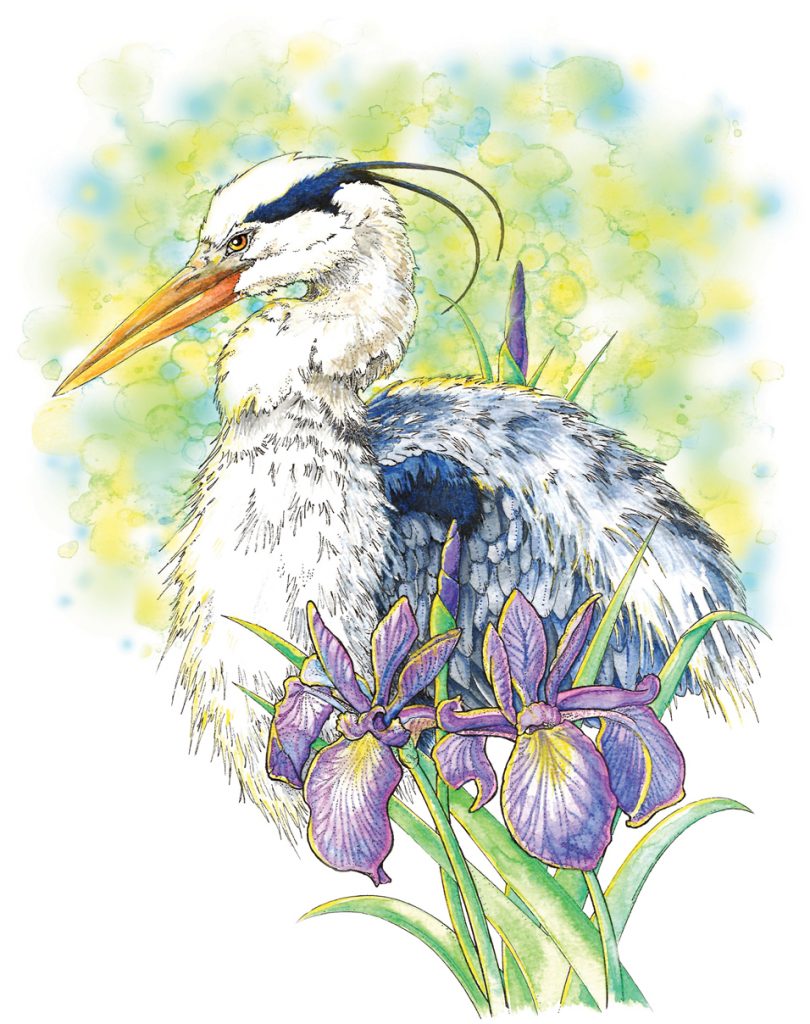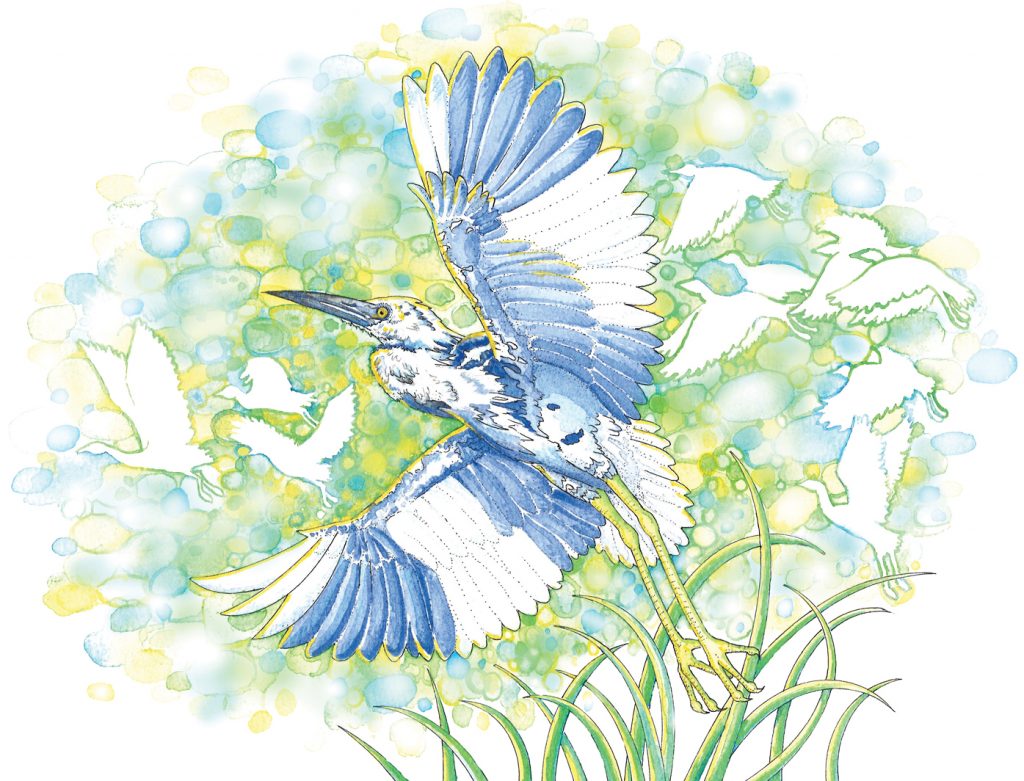By Christy Shaffer
 During a walking lunch, a large shadow passed over me. I glimpsed up to view a strange bird with slate blue-gray feathers and a long neck. Having just moved here from southwestern Pennsylvania, I’d never seen a bird that large before. It banked left and circled Silver Lake before gliding down, crying out a strange guttural, “roh-roh-rohs,” before landing at the water’s edge. I quickly snapped several photos as it gracefully stalked through the shallows of the lake, likely looking for its next meal. I was mesmerized and I needed to know more about this magnificent creature.
During a walking lunch, a large shadow passed over me. I glimpsed up to view a strange bird with slate blue-gray feathers and a long neck. Having just moved here from southwestern Pennsylvania, I’d never seen a bird that large before. It banked left and circled Silver Lake before gliding down, crying out a strange guttural, “roh-roh-rohs,” before landing at the water’s edge. I quickly snapped several photos as it gracefully stalked through the shallows of the lake, likely looking for its next meal. I was mesmerized and I needed to know more about this magnificent creature.
Upon returning to my office at the Delaware Department of Natural Resources and Environmental Control, I excitedly shared with a co-worker, “I’ve just seen a stork!”
The wildlife biologist laughed, “There are NO storks in Delaware.” So, I showed her my proof.
She smiled at me. “That’s a great blue heron, NOT a stork.”
She explained that great blue herons stand about 4-feet tall with a wingspan about 6-feet, and that even though they are large they only weigh about 5 to 6 pounds because of their hollow bones. They live near marshes, estuaries, fields, meadows, lakes and ponds where they can find food, such as fish, rodents, birds, voles, turtles, snakes, salamanders and dragonflies.
Several days later, I was tasked with creating an illustration for a game that would teach school-age children about Delaware’s wetlands featuring … drum roll please, “Yes! You guessed it, a great blue heron.”
As part of my job with the marketing communications team, I often get to visit our parks and wildlife areas to learn first-hand about what they offer the public. A tour of the then newly renovated Aquatic Resources Education Center (AREC) was followed by a walk on the boardwalk over the marsh. I got to see ghost crabs, so cute!
 The tour ended with a meeting at the Mallard Hunting Lodge, part of the former center. After the meeting, we were enjoying lunch and the warmth of the fire in the lodge. Outside the bay windows, the pond was covered with birds, including many I’d never seen before, such as egrets both snowy and great, along with one poor bird that reminded me of a calico cat. The little white bird had patches of gray and bluish feathers. I asked the AREC trainer educator, “What’s wrong with that bird?”
The tour ended with a meeting at the Mallard Hunting Lodge, part of the former center. After the meeting, we were enjoying lunch and the warmth of the fire in the lodge. Outside the bay windows, the pond was covered with birds, including many I’d never seen before, such as egrets both snowy and great, along with one poor bird that reminded me of a calico cat. The little white bird had patches of gray and bluish feathers. I asked the AREC trainer educator, “What’s wrong with that bird?”
He laughed. “The bird is fine. It’s color morphing.”
The educator explained that the bird was becoming an adult and it was a little blue heron, not a snowy egret. “People often confuse them. The young herons often hang out with groups of the snowy egrets, and they’re accepted because of their white plumage.”
“Safety in numbers?” I suggested.
He nodded yes and explained that snowy egrets have black legs and yellow feet, with black bills that are yellow very close to its eyes, while little blue herons have greenish legs and feet, and their bills are black at the tip and fade to a pale blue. He added that when the color morph is complete, the bird will no longer be calico but will have transformed into a deep, slate blue color with a purplish head and neck.
Suddenly something spooked the flock and the air filled with birds of all sizes and colors. The sight took my breath away! I noticed that the bird I’d been observing cried out a harsh, “squawk,” before taking flight and blending in with the mass of birds. I watched until they were gone. Sigh … the pond was empty. Time to go to the next meeting.
The first time I visited Trap Pond State Park in Laurel with my DNREC coworkers, I was hoping to get a photo of a green heron. This small heron is a personal favorite, probably because it reminds me of a peacock with its coppery, reddish-brown neck and iridescent forest-green plumage that it uses as camouflage.
During a long ponton boat ride on the pond, I took many photos of the fascinating bald cypress trees, and the lime-green algae pond scum that made interesting patterns across the water. But sadly, I’d failed to get the photograph of what I wanted most. At the end of the tour, I proudly showed the event’s coordinator some of my favorite shots and she showed me hers.
 Of course, she’d gotten several of a green heron stalking its quarry along the edge of the pond. I told her I hadn’t seen it. She explained, “I heard its, ‘skeow,’ cry and I knew it was close by. Looked around and spotted it in a tangle of branches.”
Of course, she’d gotten several of a green heron stalking its quarry along the edge of the pond. I told her I hadn’t seen it. She explained, “I heard its, ‘skeow,’ cry and I knew it was close by. Looked around and spotted it in a tangle of branches.”
If I had been listening instead of just looking, I might’ve gotten to seen it for myself. Alas … maybe next time.
In my research on green herons, I found this fun fact: the clever green heron is one of the world’s few tool-using birds. It often uses objects such as insects, feathers and other items as fishing lures by dropping them on the surface of the water to entice small fish. Standing patiently and still on the shore, in shallow water or perched on branches, they await their prey. The unsuspecting fish takes the bait, and the little heron has dinner.
I have a list of birds I have yet to see. Recently, I crossed the bald eagle off that list. However, the tricolor heron has eluded me at every visit to a state park or wildlife area. But that is part of the fun. With every visit I increase my chances of seeing or maybe even getting to photograph it.
Research can help improve those odds. I’ve learned that the tricolor heron lives and hunts in marshes, swamps and streams. However, during breeding season it prefers areas around salt water such as estuaries, tidal marshes and bays. When I’m observing a flock of birds, I have to remember to search for the heron that is farther away. Tricolored herons tend to be loners that stay around the outer rim.
What I’m looking for is a colorful bird with bluish-gray, amethyst feathers and a white stripe that extends from under its neck all the way to its white belly. These white markings help tell it apart from the other herons.
I also checked on the sounds a tri-colored heron makes. I wasn’t going to miss another opportunity by not knowing their vocalizations, “Aaah” or “Aahrr.”
For fun, download a coloring page of the tricolored heron. Then, share your pages with us on Facebook, X (Formerly Known as Twitter) or Instagram @DelawareDNREC.
Christy Shaffer is a designer and printing tech with DNREC. She sketched these illustrations in pencil, outlined with a KOH-I-NOOR Rapidograph pen in black India ink, and painted with watercolor techniques using Dr. Ph. Martin’s Iridescent calligraphy color inks.